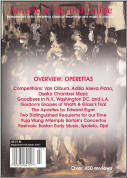Texte paru dans: / Appeared in: |
|
|
Outil de traduction ~ (Très approximatif) |
|
|
Reviewer: Peter
Loewen
This program concentrates on
works from Machaut’s early years, before 1350—mostly virelais and motets,
but there are also three ballads and a rondeau. The program concludes with
the massive ‘Lay de Consolation Pour Ce que Plus Proprement’, which is a
late work attributed to Machaut. According to tradition, Machaut’s works in
each genre are numbered. The program includes virelais 5, 12, 22, and 23;
ballades 8, 9, and 21; motets 4 and 7; rondeau 5; and lay 23. 33 of
Machaut’s 39 virelais are set to music, and 25 of them are monophonic. The
melodic simplicity of the virelai might have reminded listeners of its roots
in 13th-Century dance song. In fact, the melody of Virelai 5, ‘Comment Qu’a
Moy Lonteinne’, harkens to an anonymous trouvere song known as ‘Belle Doette’.
‘Tres Bonne et Bell’ (23) is the only three-part work in this genre, but its
design is much simpler than the three-part motets. Motets have rigorously
repeating rhythmic and melodic patterns in a chant tenor, while the upper
two voices declaim different but related texts. The ballades and rondeau are
complicated by melismas and structures that use a larger number of melodies
(ballade), or a more convoluted repetitive structure (rondeau). The
performance practice of these polyphonic genres has a been a source of some
controversy—should lower voices adapt the text of the cantus part as best
they can or should they sing their parts as melismatic vocalizations? In
Ballade 21, ‘Se Quanque Amours’, it sounds as though the lower voice or
voices have decided not to sing the words. This is significant; it
unclutters the texture and places the emphasis where it seems to belong—on
the voice(s) to which the scribes actually affixed the text. The effect is
most striking in the two-voice songs: ‘Quant J’ay L’espart’ (Rondeau 5);
‘Dame, ne Regardés Pas’ (Ballade 9); and ‘De Desconfort’ (Ballade 8), where
Donald Greig’s wordless baritone melismas offer the perfect accompaniment.
This may also be more authentic, as it seems to illustrate what Machaut’s
pupil Eustache Deschamps describes as “musique naturelle”, where tenor parts
were to be sung “par art, sanz parole”.
Listening even to the simplest
virelais illustrates Machaut’s rich imagination. And each of the three
monophonic ones here is sung by a different soloist, which adds to the
variety. The alternation of long and short phrases in Virelai 12, Dame, a
Qui’ (Matthew Verner), holds one’s attention through the variation of long
and iambic meters. On the other hand, the short, chopped phrases of Virelai
22, ‘Foy Porter’ (Angus Smith), emphasizes a tight rhyme scheme, as the
melody wanders from one range to another. ‘Comment Qu’a Moy Lonteinne’
(Donald Greig) has an irregular meter, which emphasizes Machaut’s graceful
melodic writing. Although the polyphonic works are much more complicated,
the Orlando Consort makes the precious nuances of Machaut’s music sound
effortless. Texts and notes are in English. | |
|
Support us financially by purchasing this disc from eiher one of these
suppliers. Un achat via l'un ou l'autre des fournisseurs proposés contribue à défrayer les coûts d'exploitation |
|
|
|
|
|
Cliquez l'un ou l'autre
bouton pour découvrir bien d'autres critiques de CD |
|




